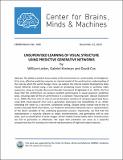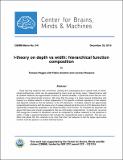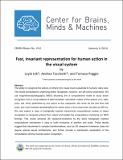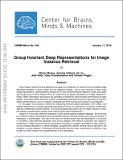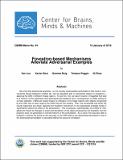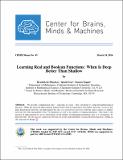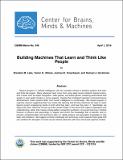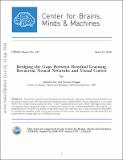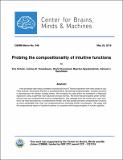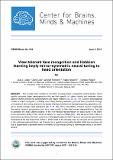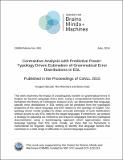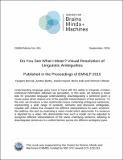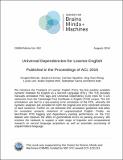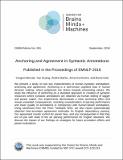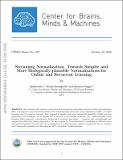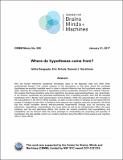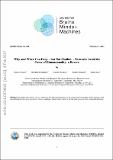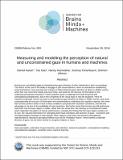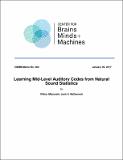Browsing CBMM Memo Series by Issue Date
Now showing items 41-60 of 141
-
UNSUPERVISED LEARNING OF VISUAL STRUCTURE USING PREDICTIVE GENERATIVE NETWORKS
(Center for Brains, Minds and Machines (CBMM), arXiv, 2015-12-15)The ability to predict future states of the environment is a central pillar of intelligence. At its core, effective prediction requires an internal model of the world and an understanding of the rules by which the world ... -
I-theory on depth vs width: hierarchical function composition
(Center for Brains, Minds and Machines (CBMM), 2015-12-29)Deep learning networks with convolution, pooling and subsampling are a special case of hierar- chical architectures, which can be represented by trees (such as binary trees). Hierarchical as well as shallow networks can ... -
Fast, invariant representation for human action in the visual system
(Center for Brains, Minds and Machines (CBMM), arXiv, 2016-01-06)The ability to recognize the actions of others from visual input is essential to humans' daily lives. The neural computations underlying action recognition, however, are still poorly understood. We use magnetoencephalography ... -
Group Invariant Deep Representations for Image Instance Retrieval
(Center for Brains, Minds and Machines (CBMM), 2016-01-11)Most image instance retrieval pipelines are based on comparison of vectors known as global image descriptors between a query image and the database images. Due to their success in large scale image classification, ... -
Foveation-based Mechanisms Alleviate Adversarial Examples
(Center for Brains, Minds and Machines (CBMM), arXiv, 2016-01-19)We show that adversarial examples, i.e., the visually imperceptible perturbations that result in Convolutional Neural Networks (CNNs) fail, can be alleviated with a mechanism based on foveations---applying the CNN in ... -
Learning Real and Boolean Functions: When Is Deep Better Than Shallow
(Center for Brains, Minds and Machines (CBMM), arXiv, 2016-03-08)We describe computational tasks - especially in vision - that correspond to compositional/hierarchical functions. While the universal approximation property holds both for hierarchical and shallow networks, we prove that ... -
Building machines that learn and think like people
(Center for Brains, Minds and Machines (CBMM), arXiv, 2016-04-01)Recent progress in artificial intelligence (AI) has renewed interest in building systems that learn and think like people. Many advances have come from using deep neural networks trained end-to-end in tasks such as object ... -
Bridging the Gaps Between Residual Learning, Recurrent Neural Networks and Visual Cortex
(Center for Brains, Minds and Machines (CBMM), arXiv, 2016-04-12)We discuss relations between Residual Networks (ResNet), Recurrent Neural Networks (RNNs) and the primate visual cortex. We begin with the observation that a shallow RNN is exactly equivalent to a very deep ResNet with ... -
Probing the compositionality of intuitive functions
(Center for Brains, Minds and Machines (CBMM), 2016-05-26)How do people learn about complex functional structure? Taking inspiration from other areas of cognitive science, we propose that this is accomplished by harnessing compositionality: complex structure is decomposed into ... -
View-tolerant face recognition and Hebbian learning imply mirror-symmetric neural tuning to head orientation
(Center for Brains, Minds and Machines (CBMM), arXiv, 2016-06-03)The primate brain contains a hierarchy of visual areas, dubbed the ventral stream, which rapidly computes object representations that are both specific for object identity and relatively robust against identity-preserving ... -
Contrastive Analysis with Predictive Power: Typology Driven Estimation of Grammatical Error Distributions in ESL
(Center for Brains, Minds and Machines (CBMM), arXiv, 2016-06-05)This work examines the impact of crosslinguistic transfer on grammatical errors in English as Second Language (ESL) texts. Using a computational framework that formalizes the theory of Contrastive Analysis (CA), we demonstrate ... -
Do You See What I Mean? Visual Resolution of Linguistic Ambiguities
(Center for Brains, Minds and Machines (CBMM), arXiv, 2016-06-10)Understanding language goes hand in hand with the ability to integrate complex contextual information obtained via perception. In this work, we present a novel task for grounded language understanding: disambiguating a ... -
Universal Dependencies for Learner English
(Center for Brains, Minds and Machines (CBMM), arXiv, 2016-08-01)We introduce the Treebank of Learner English (TLE), the first publicly available syntactic treebank for English as a Second Language (ESL). The TLE provides manually annotated POS tags and Universal Dependency (UD) trees ... -
Deep vs. shallow networks : An approximation theory perspective
(Center for Brains, Minds and Machines (CBMM), arXiv, 2016-08-12)The paper briefly reviews several recent results on hierarchical architectures for learning from examples, that may formally explain the conditions under which Deep Convolutional Neural Networks perform much better in ... -
Anchoring and Agreement in Syntactic Annotations
(Center for Brains, Minds and Machines (CBMM), arXiv, 2016-09-21)Published in the Proceedings of EMNLP 2016 We present a study on two key characteristics of human syntactic annotations: anchoring and agreement. Anchoring is a well-known cognitive bias in human decision making, where ... -
Streaming Normalization: Towards Simpler and More Biologically-plausible Normalizations for Online and Recurrent Learning
(Center for Brains, Minds and Machines (CBMM), arXiv, 2016-10-19)We systematically explored a spectrum of normalization algorithms related to Batch Normalization (BN) and propose a generalized formulation that simultaneously solves two major limitations of BN: (1) online learning and ... -
Where do hypotheses come from?
(Center for Brains, Minds and Machines (CBMM), 2016-10-24)Why are human inferences sometimes remarkably close to the Bayesian ideal and other times systematically biased? One notable instance of this discrepancy is that tasks where the candidate hypotheses are explicitly available ... -
Theory I: Why and When Can Deep Networks Avoid the Curse of Dimensionality?
(Center for Brains, Minds and Machines (CBMM), arXiv, 2016-11-23)[formerly titled "Why and When Can Deep – but Not Shallow – Networks Avoid the Curse of Dimensionality: a Review"] The paper reviews and extends an emerging body of theoretical results on deep learning including the ... -
Measuring and modeling the perception of natural and unconstrained gaze in humans and machines
(Center for Brains, Minds and Machines (CBMM), arXiv, 2016-11-28)Humans are remarkably adept at interpreting the gaze direction of other individuals in their surroundings. This skill is at the core of the ability to engage in joint visual attention, which is essential for establishing ... -
Learning Mid-Level Auditory Codes from Natural Sound Statistics
(Center for Brains, Minds and Machines (CBMM), arXiv, 2017-01-25)Interaction with the world requires an organism to transform sensory signals into representations in which behaviorally meaningful properties of the environment are made explicit. These representations are derived through ...

